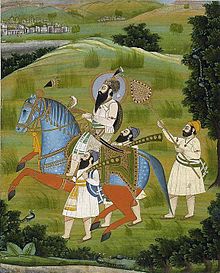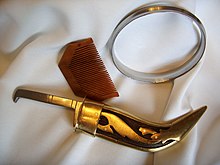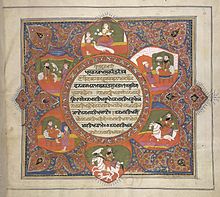Guru Gobind Singh
Guru Gobind Singh
| Guru Gobind Singh ਗੁਰੂ ਗੋਬਿੰਦ ਸਿੰਘ |
|
|---|---|

|
|
| Religion | Sikhism |
| Known for | Founding the Khalsa[1] Wrote Jaap Sahib, Chandi di Var, Tav-Prasad Savaiye, Zafarnamah, Bachittar Natak, Akal Ustat, Chaupai (Sikhism) |
| Other names | Tenth Nanak[2] |
| Personal | |
| Born | Gobind Rai 22 December 1666 Patna Sahib (Present day India) |
| Died | 7 October 1708 (aged 41) Hazur Sahib Nanded (Present day India) |
| Spouse | Mata Jito, Mata Sundari and Mata Sahib Devan[3] |
| Children | Ajit Singh Jujhar Singh Zorawar Singh Fateh Singh |
| Parents | Guru Tegh Bahadur, Mata Gujri |
| Religious career | |
| Predecessor | Guru Tegh Bahadur |
| Successor | Guru Granth Sahib |
| Part of a series on |
| Sikhism |
|---|
 |
Guru Gobind Singh, born Gobind Rai (22 December 1666 – 7 October 1708),[4][5] was the 10th Sikh Guru, a spiritual master, warrior, poet and philosopher. When his father, Guru Tegh Bahadur, was beheaded for refusing to convert to Islam,[6][7] Guru Gobind Singh was formally installed as the leader of the Sikhs at age nine, becoming the last of the living Sikh Gurus.[8] His four sons died during his lifetime in Mughal-Sikh wars – two in battle, two executed by the Mughal army.[9][10][11]
Among his notable contributions to Sikhism are founding the Sikh warrior community called Khalsa in 1699[1][12][13] and introducing the Five Ks, the five articles of faith that Khalsa Sikhs wear at all times. Guru Gobind Singh also continued the formalisation of the religion, wrote important Sikh texts,[14][15] and enshrined the scripture the Guru Granth Sahib as Sikhism's eternal Guru.[16]
Family and early life[edit]
Gobind Singh was the only son of Guru Tegh Bahadur, the ninth Sikh guru, and Mata Gujri. He was born in Patna (Bihar), while his father was visiting Bengal and Assam.[4] His birth name was Gobind Rai, and a shrine named Takht Sri Patna Harimandar Sahib marks the site of the house where he was born and spent the first four years of his life.[4] In 1670, his family returned to Punjab, and in March 1672 they moved to Chakk Nanaki in the Himalayan foothills of north India, called the Sivalik range, where he was schooled.[4][12] Gobind Singh's father Tegh Bahadur founded the city of Chakk Nanaki, now known as Anandpur Sahib, in 1665, on land purchased from the ruler of Bilaspur (Kahlur).[citation needed]
His father Guru Tegh Bahadur was petitioned by Kashmiri Pandits[17] in 1675 for protection from the fanatic persecution by Iftikar Khan, an Islamic satrap of the Mughal Emperor Aurangzeb.[4] Tegh Bahadur considered a peaceful resolution by meeting Aurangzeb, but was cautioned by his advisors that his life may be at risk. The young Gobind Rai – to be known as Gobind Singh after 1699[5] – advised his father that no one was more worthy to lead and make a sacrifice than him.[4] His father made the attempt, but was arrested then publicly beheaded in Delhi on 11 November 1675 under the orders of Aurangzeb for refusing to convert to Islam and the on-going conflicts between Sikhism and the Islamic Empire.[18][19] After this martyrdom, the young Gobind Rai was installed by the Sikhs as the tenth Sikh Guru on Vaisakhi on March 29, 1676.[20]
The education of Guru Gobind Singh continued after he became the 10th Guru, both in reading and writing as well as martial arts such as horse riding and archery. In 1684, he wrote the Chandi di Var in Punjabi language – a legendary war between the good and the evil, where the good stands up against injustice and tyranny, as described in the ancient Sanskrit text Markandeya Purana.[4] He stayed in Paonta, near the banks of river Yamuna, till 1685.[4]
Guru Gobind Singh had three wives:[3][21]
- at age 10, he married Mata Jito on 21 June 1677 at Basantgaṛh, 10 km north of Anandpur. The couple had three sons: Jujhar Singh (b. 1691), Zorawar Singh (b. 1696) and Fateh Singh (b. 1699).[22]
- at age 17, he married Mata Sundari on 4 April 1684 at Anandpur. The couple had one son, Ajit Singh (b. 1687).[23]
- at age 33, he married Mata Sahib Devan on 15 April 1700 at Anandpur. They had no children, but she had an influential role in Sikhism. Guru Gobind Singh proclaimed her as the Mother of the Khalsa.[24]
The life example and leadership of Guru Gobind Singh has been of historic importance to the Sikhs. He institutionalized the Khalsa (literally, Pure Ones), which played the key role in protecting the Sikhs long after his death, such as during the nine invasions of Panjab and holy war led by Ahmad Shah Abdali from Afghanistan between 1747 and 1769.[5]
Founding the Khalsa[edit]
In 1699, the Guru requested the Sikhs to congregate at Anandpur on Vaisakhi (the annual spring harvest festival).[25]According to the Sikh tradition, he asked for a volunteer from those who gathered, someone willing to sacrifice his head. One came forward, whom he took inside a tent. The Guru returned to the crowd without the volunteer, but with a bloody sword.[25] He asked for another volunteer, and repeated the same process of returning from the tent without anyone and with a bloodied sword four more times. After the fifth volunteer went with him into the tent, the Guru returned with all five volunteers, all safe. He called them the Panj Pyare and the first Khalsa in the Sikh tradition.[25]
Guru Gobind Singh then mixed water and sugar into an iron bowl, stirring it with a double-edged sword to prepare what he called Amrit ("nectar"). He then administered this to the Panj Pyare, accompanied with recitations from the Adi Granth, thus founding the khande ka pahul (baptization ceremony) of a Khalsa – a warrior community.[25][26] The Guru also gave them a new surname "Singh" (lion). After the first five Khalsa had been baptized, the Guru asked the five to baptize him as a Khalsa. This made the Guru the sixth Khalsa, and his name changed from Guru Gobind Rai to Guru Gobind Singh.[25]
Guru Gobind Singh initiated the Five K's tradition of the Khalsa,[27]
- Kesh: uncut hair.
- Kangha: a wooden comb.
- Kara: an iron or steel bracelet worn on the wrist.
- Kirpan: a sword.
- Kacchera: short breeches.
He also announced a code of discipline for Khalsa warriors. Tobacco, eating meat slaughtered according to Muslim ritual and sex with Muslims were forbidden.[27][28] The Khalsas also agreed to never interact with those who followed rivals or their successors.[27] The co-initiation of men and women from different castes into the ranks of Khalsa also institutionalized the principle of equality in Sikhism regardless of one's caste or gender.[28] According to Owen and Sambhi, Guru Gobind Singh's significance to the Sikh tradition has been very important, as he institutionalized the Khalsa, resisted the ongoing persecution by the Mughal Empire, and continued "the defense of Sikhism and Hinduism against the Muslim assault of Aurangzeb".[29]
He introduced ideas that indirectly challenged the discriminatory taxes imposed by Islamic authorities. For example, Aurangzeb had imposed taxes on non-Muslims that were collected from the Sikhs as well, for example the jizya (poll tax on non-Muslims), pilgrim tax and Bhaddar tax – the last being a tax to be paid by anyone following the Hindu ritual of shaving the head after the death of a loved one and cremation.[1] Guru Gobind Singh declared that Khalsa do not need to continue this practice, because Bhaddar is not dharam, but a bharam (illusion).[1][30] Not shaving the head also meant not having to pay the taxes by Sikhs who lived in Delhi and other parts of the Mughal Empire.[1] However, the new code of conduct also led to internal disagreements between Sikhs in the 18th century, particularly between the Nanakpanthi and the Khalsa.[1]
Guru Gobind Singh had deep respect for the Khalsa, and stated that there is no difference between the True Guru and the sangat (panth).[31] Before his founding of the Khalsa, the Sikh movement had used the Sanskrit word Sisya (literally, disciple or student), but the favored term thereafter became Khalsa.[32] Additionally, prior to the Khalsa, the Sikh congregations across India had a system of Masands appointed by the Sikh Gurus. The Masands led the local Sikh communities, local temples, collected wealth and donations for the Sikh cause.[32] Guru Gobind Singh concluded that the Masands system had become corrupt, he abolished them and introduced a more centralized system with the help of Khalsa that was under his direct supervision.[32] These developments created two groups of Sikhs, those who initiated as Khalsa, and others who remained Sikhs but did not undertake the initiation.[32] The Khalsa Sikhs saw themselves as a separate religious entity, while the Nanak-panthi Sikhs retained their different perspective.[33][34]
The Khalsa warrior community tradition started by Guru Gobind Singh has contributed to modern scholarly debate on pluralism within Sikhism. His tradition has survived into the modern times, with initiated Sikh referred to as Khalsa Sikh, while those who do not get baptized referred to as Sahajdhari Sikhs.[35][36][37]
Sikh scriptures[edit]
In the 16th and 17th century, multiple and different versions of the Sikh scripture by unknown authors, all claiming to be the words of Guru Nanak were in circulation. Guru Arjan (d. 1606) attempted to remove corruption and interpolation of the text, and compiled a purer version of the Adi Granth.[40] In the 17th century, the text was called the Pothi, and three manuscripts claimed to be authentic, one Kartarpur version (dated 1604), the other a bit larger Khara Mangat version (dated 1642), and the third quite different Lahore version of the Adi Granth (date unknown).[41]
Guru Gobind Singh is credited in the Sikh tradition with finalizing the Kartarpur Pothi into the Guru Granth Sahib in Bathinda and releasing it in 1706.[41] The final version did not accept the extraneous hymns in other versions, and included the compositions of his father Guru Tegh Bahadur.[41] Guru Gobind Singh also declared this text to be the eternal Guru for Sikhs.[16]
Guru Gobind Singh composed other texts, particularly the Dasam Granth which many Sikhs consider to be a scripture next in importance after the Guru Granth Sahib.[42][43] The Dasam Granth includes compositions such as the Jaap Sahib , Amrit Savaiye and Benti Chaupai which are part of the daily prayers/lessons (Nitnem) of Sikhs.[44] The Dasam Granth is largely versions of Indian theology from the Puranas and secular stories.[45][46][47]
Wars[edit]
When all other means have failed,
It is but lawful to take to the sword.
According to Torkel Brekke, the period following the execution of Guru Tegh Bahadur – the father of Guru Gobind Singh, was a period where the Mughal Empire under Aurangzeb was an increasingly hostile enemy of the Sikh people.[50] The Sikh resisted, led by Gobind Singh, and the Muslim-Sikh conflicts peaked during this period.[50] Both Mughal administration and Aurangzeb's army had an active interest in Guru Gobind Singh. According to J.S. Grewal, at one time Aurangzeb issued an order to exterminate Guru Gobind Singh and his family.[51]
Guru Gobind Singh saw his mission, states Brekke, as God given to resist tyranny and false religion he considered Islam to be.[50] According to Christopher Wright, Guru Gobind Singh believed in a Dharam Yudh (war in defense of righteousness), something that is fought as a last resort, neither out of a wish for revenge nor for greed nor for any destructive goals.[52] To Guru Gobind Singh, one must be prepared to die to stop tyranny, end persecution and to defend one's own religious values.[52] He led fourteen wars with these objectives, but never took captives nor damaged anyone's place of worship.[52]
Significant battles[edit]
- Battle of Bhangani (1688), which states chapter 8 of Gobind Singh's Bicitra Natak, when Fateh Shah, along with mercenary commanders Hayat Khan and Najabat Khan,[53] attacked his forces without any purpose. The Guru was aided by forces of Kripal (his maternal uncle) and a Brahmin named Daya Ram, both of whom he praises as heroes in his text.[54] The Guru's cousin named Sango Shah was killed in the battle, a cousin from Guru Hargobind's daughter.[53]
- Battle of Nadaun (1691), against the Islamic armies of Mian Khan and his son Alif Khan, who were defeated by the allied forces of Guru Gobind Singh, Bhim Chand and other Hindu kings of Himalayan foothills.[55] The non-Muslims aligned to the Guru had refused to pay tribute to the Islamic officials based in Jammu.[53]
In 1693, Aurangzeb was fighting the Hindu Marathas in the Deccan region of India, and he issued orders that Guru Gobind Singh and Sikhs should be prevented from gathering in Anandpur in large numbers.[53][56]
- Battle of Guler (1696), first against the Muslim commander Dilawar Khan's son Rustam Khan, near Sutlej river, where the Guru teamed up with the Hindu king of Guler and routed the Muslim army.[57] The commander sent his general Hussain Khan against the armies of the Guru and the Guler kingdom, a war fought near Pathankot, and Hussain Khan was defeated and killed by the joint forces.[57]
- First Battle of Anandpur (1700), against the Mughal army of Aurangzeb, who had sent 10,000 soldiers under the command of Painda Khan and Dina Beg.[58] In a direct combat between Guru Gobind Singh and Painda Khan, the latter was killed. His death led to the Mughal army fleeing the battlefield.[58]
- Battle of Anandpur Sahib (1701), against the neighboring Hindu kingdom chiefs who controlled the mountain kingdoms. This was accompanied by a battle wherein Jagatullah was killed by Sikh forces.[58] The hill chiefs laid a siege of Anandpur, and the Guru had to temporarily leave Anandpur as a condition for peace.[59] According to Louis Fenech, his wars with kings of the Himalayan kingdoms was likely triggered by the growing army of Sikhs, which then raided and plundered villages in nearby mountainous kingdoms for supplies; the Hindu kings joined forces and blockaded Anandpur.[56]
- Battle of Nirmohgarh (1702), against the forces of Aurangzeb, led by Wazir Khan on the banks of Nirmohgarh. The battle continued for two days, with heavy losses on both sides, and Wazir Khan army left the battlefield.
- Battle of Basoli (1702), against the Mughal army; named after the kingdom of Basoli whose Raja Dharampul supported the Guru in the battle.[60] The Mughal army was supported by rival kingdom of Kahlur led by Raja Ajmer Chand. The battle ended when the two sides reached a tactical peace.[60]
- Battle of Anandpur (1704), against the Mughal army led first by Saiyad Khan and then by Ramjan Khan;[58] The Mughal general was fatally wounded by Sikh soldiers, and the army withdrew. Aurangzeb then sent a larger army with two generals, Wazir Khan and Zaberdast Khan in May 1704, to destroy the Sikh resistance.[58] The approach the Islamic army took in this battle was to lay a protracted siege against Anandpur, from May to December, cutting off all food and other supplies moving in and out, along with repeated battles.[61] Some Sikh men deserted the Guru during Anandpur siege in 1704, and escaped to their homes where their women shamed them and they rejoined the Guru's army and died fighting with him in 1705.[62][63] Towards the end, the Guru, his family and followers accepted an offer by Aurangzeb of safe passage out of Anandpur.[64] However, as they left Anandpur in two batches, they were attacked, and one of the batches with Mata Gujari and Guru's two sons – Zorawar Singh aged 8 and Fateh Singh aged 5 – were taken captive by the Mughal army.[59][65] Both his children were executed by burying them alive into a wall.[61][66] The grandmother Mata Gujari died there as well.[59]
- Battle of Sarsa (1704), against the Mughal army led by general Wazir Khan; the Muslim commander had conveyed Aurangzeb's promise of a safe passage to Guru Gobind Singh and his family in early December.[65] However, when the Guru accepted the offer and left, Wazir Khan took captives, executed them and pursued the Guru.[67] The retreating troops he was with were repeated attacked from behind, with heavy casualties to the Sikhs, particularly while crossing the Sarsa river.[67]
- Battle of Chamkaur (1704) Regarded as one of the most important battle of the sikh history. It was against the Mughal army led by Nahar Khan;[68] the Muslim commander was killed,[68] while on Sikh side the remaining two elder sons of the Guru – Ajit Singh and Jujhar Singh, along with other Sikh soldiers were killed in this battle.[59][69]
- Battle of Muktsar (1705), the Guru's army was re-attacked by the Mughal army, being hunted down by general Wazir Khan, in the arid area of Khidrana-ki-Dhab. The Mughals were blocked again, but with many losses of Sikh lives – particularly the famous Chalis Mukte (literally, the "forty liberated ones"),[63] and this was the last battle led by Guru Gobind Singh.[70] The place of battle called Khidrana was renamed about a 100 years later by Ranjit Singh to Mukt-sar (literally, "lake of liberation"), after the term "Mukt" (moksha) of the ancient Indian tradition, in honor of those who gave their lives for the cause of liberation.[71]
Death of family members[edit]
Meanwhile, Guru's mother Mata Gujri and his two younger sons were captured by Wazir Khan, the Muslim governor of Sirhind. According to the Sikh tradition, his youngest sons, aged 5 and 8, were executed by burying them alive into a wall after they refused to convert to Islam, and Mata Gujri died soon after hearing of her grandsons' death.[61] Both his eldest sons, aged 13 and 17, also died in December 1704 in battle against the Mughal army as they defended their father.[61]
Mughal accounts[edit]
The Muslim historians of the Mughal court wrote about Guru Gobind Singh as well as the geopolitics of the times he lived in, and these official Persian accounts were the readily available and the basis of colonial era English-language description of Sikh history.[72][73]
According to Dhavan, the Persian texts that were composed by Mughal court historians during the lifetime of Guru Gobind Singh were hostile to him, but presented the Mughal perspective.[72] They believed that the religious Guru tradition of Sikhs had been corrupted by him, through the creation of a military order willing to resist the Imperial army.[72] Dhavan writes that some Persian writers who wrote decades or a century after the death of Guru Gobind Singh evolved from relying entirely on court histories of the Mughals which disparage the Guru, to including stories from the Sikh gurbilas text that praise the Guru.[72][74]
The Mughal accounts suggest that the Muslim commanders viewed the Sikh panth as one divided into sects with different loyalties, and after the battle of Anandpur, the Mughals felt that the Guru's forces had become a small band of left over warriors.[75]
Post-war years[edit]
After the Second Battle of Anandpur in 1704, the Guru and his remaining soldiers moved and stayed in different spots including hidden in places such as the Machhiwara jungle of southern Panjab.[65]
Some of the various spots in north, west and central India that the Guru lived after 1705, include Hehar with Kirpal Das (maternal uncle), Manuke, Mehdiana, Chakkar, Takhtupura and Madhe and Dina (Malwa (Punjab) region). He stayed with relatives or trusted Sikhs such as the three grandsons of Rai Jodh, a devotee of Guru Har Gobind.[76]
Zafarnama[edit]
According to the Sikh tradition, Guru Gobind Singh saw the war conduct of Aurangzeb and his army against his family and his people as a betrayal of a promise, unethical, unjust and impious.[65] After all of Guru Gobind Singh's children had been killed by the Mughal army and the battle of Muktsar, the Guru wrote a defiant letter in Persian to Aurangzeb, titled Zafarnama (literally, "epistle of victory"), a letter which the Sikh tradition made a part of the Dasam Granth towards the end of the 19th century.[65][77][78]
The Guru's letter was stern yet conciliatory to Aurangzeb. He indicted the Mughal Emperor and his commanders in spiritual terms, accused them of a lack of morality both in governance and in the conduct of war.[79] The letter predicted that the Mughal Empire would soon end, because it persecutes, is full of abuse, falsehood and immorality. The letter is spiritually rooted in Guru Gobind Singh's beliefs about justice and dignity without fear.[79]
The Zafarnama letter also includes text towards the end that praises Aurangzeb as a human being by calling him as a charitable one with "brilliant conscience, handsome body and the king of kings", and then seeks a personal meeting between the Guru and the Emperor for a reconciliatory dialogue.[79] Aurangzeb received the letter in 1705, agreed to a meeting in 1706 for which Guru Gobind Singh travelled to Ahmadnagar.[65] However, Aurangzeb never met the Guru, and the Mughal Emperor died in 1707.[65]
Final days[edit]
Aurangzeb died in 1707, and immediately a succession struggle began between his sons who attacked each other.[80]The official successor was Bahadur Shah, who invited Guru Gobind Singh with his army to meet him in person in the Deccan region of India, for a reconciliation but Bahadur Shah then delayed any discussions for months.[61][80]
Wazir Khan, a Muslim army commander against whose army the Guru had fought several wars,[70] commissioned two Afghans, Jamshed Khan and Wasil Beg, to follow the Guru's army as it moved for the meeting with Bahadur Shah, and then assassinate the Guru. The two secretly pursued the Guru whose troops were in the Deccan area of India, and entered the camp when the Sikhs had been stationed near river Godavari for months.[81] They gained access to the Guru and Jamshed Khan stabbed him with a fatal wound at Nanded.[61][82] Some scholars state that the assassin who killed Guru Gobind Singh may not have been sent by Wazir Khan, but was instead sent by the Mughal army that was staying nearby.[70]
According to Senapati's Sri Gur Sobha, an early 18th century writer, the fatal wounds of the Guru was one below his heart. The Guru fought back and killed the assassin, while the assassin's companion was killed by the Sikh guards as he tried to escape.[81]
The Guru died of his wounds a few days later on 7 October 1708[83] His death fueled a long and bitter war of the Sikhs with the Mughals.[81]
See also[edit]








